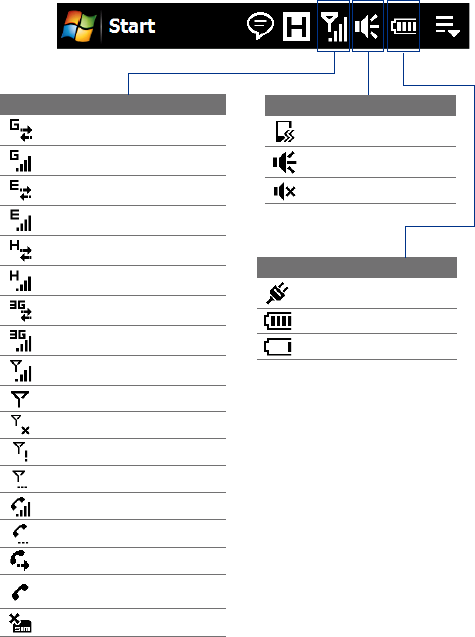Operation Manual
Table Of Contents
- Chapter 1 Getting Started
- 1.1 Getting to Know Your Touch Phone and Accessories
- 1.2 Installing the SIM Card and Battery
- 1.3 Charging the battery
- 1.4 Using the Strap Holder
- 1.5 Starting Up
- 1.6 Navigating Your Device
- 1.7 Home Screen
- 1.8 Status Icons
- 1.9 Start Menu
- 1.10 Quick Menu
- 1.11 LED Alerts
- 1.12 Adjusting the Volume
- 1.13 Using your Device as a USB Drive
- Chapter 2 Using Phone Features
- Chapter 3 TouchFLO™ 3D
- Chapter 4 Entering Text
- Chapter 5 Synchronizing Information With Your Computer
- Chapter 6 Exchanging Messages
- Chapter 7 Working With Company E-mails and Meeting Appointments
- Chapter 8 Internet
- Chapter 9 Bluetooth
- Chapter 10 Navigating on the Road
- Chapter 11 Experiencing Multimedia
- Chapter 12 Programs
- Chapter 13 Managing Your Device
- Appendix
- Index
- 5.1 About Synchronization
- 5.2 Setting Up Windows Mobile® Device Center on Windows Vista®
- 5.3 Setting Up ActiveSync® on Windows XP®
- 5.4 Synchronizing With Your Computer
- 5.5 Synchronizing via Bluetooth
- 5.6 Synchronizing Music and Video
- 12.1 Programs on your Device
- 12.2 Adding and Removing Programs
- 12.3 Adobe® Reader® LE
- 12.4 Calendar
- 12.5 Contacts
- 12.6 Comm Manager
- 12.7 Microsoft® Office Mobile
- 12.8 Notes
- 12.9 Java
- 12.10 SIM Manager
- 12.11 Spb GPRS Monitor (Available by Country)
- 12.12 Sprite Backup
- 12.13 Tasks
- 12.14 Voice Recorder
- 12.15 Voice Speed Dial
- 12.16 ZIP

38 Getting Started
Icons that appear in this area
Battery charging
Battery full
Battery very low
Icons that appear in this area
Vibrate mode
Sound on
Sound off
Icons that appear in this area
GPRS connecting
GPRS in use
EDGE connecting
EDGE in use
HSDPA connecting
HSDPA in use
WCDMA/UMTS connecting
WCDMA/UMTS in use
Maximum signal strength
No signal
Phone is turned off
No phone service
Searching for phone service
Voice call in progress
Call on hold
Calls are forwarded
Dialing while no SIM card is
inserted
No SIM card inserted










